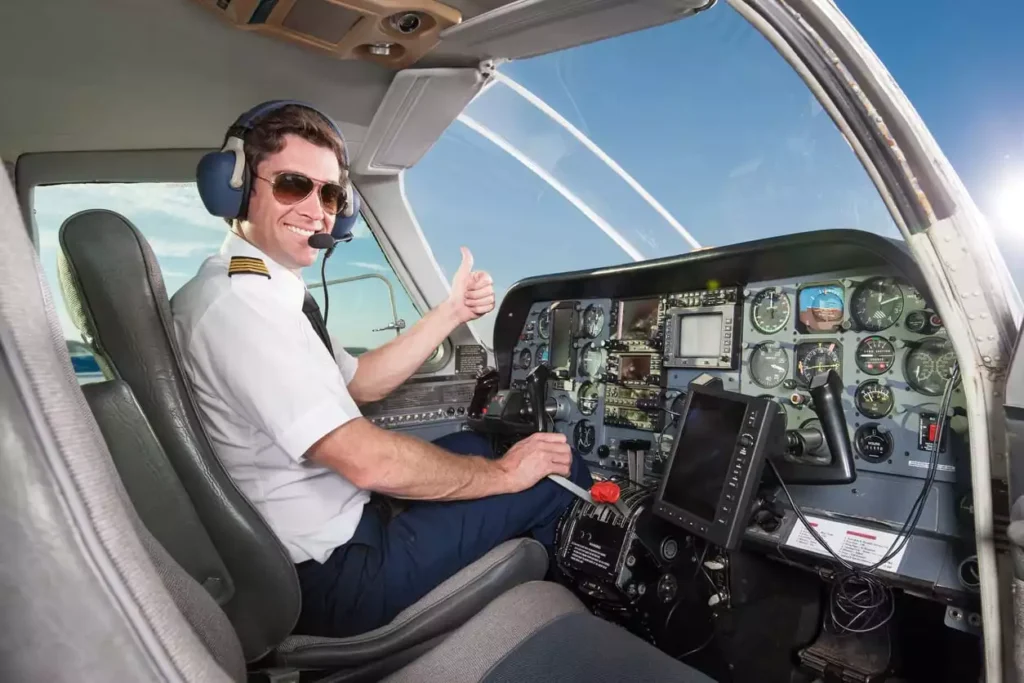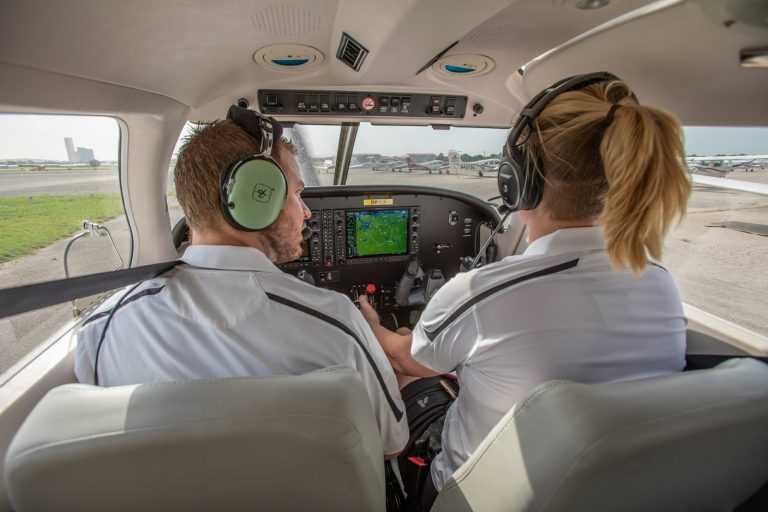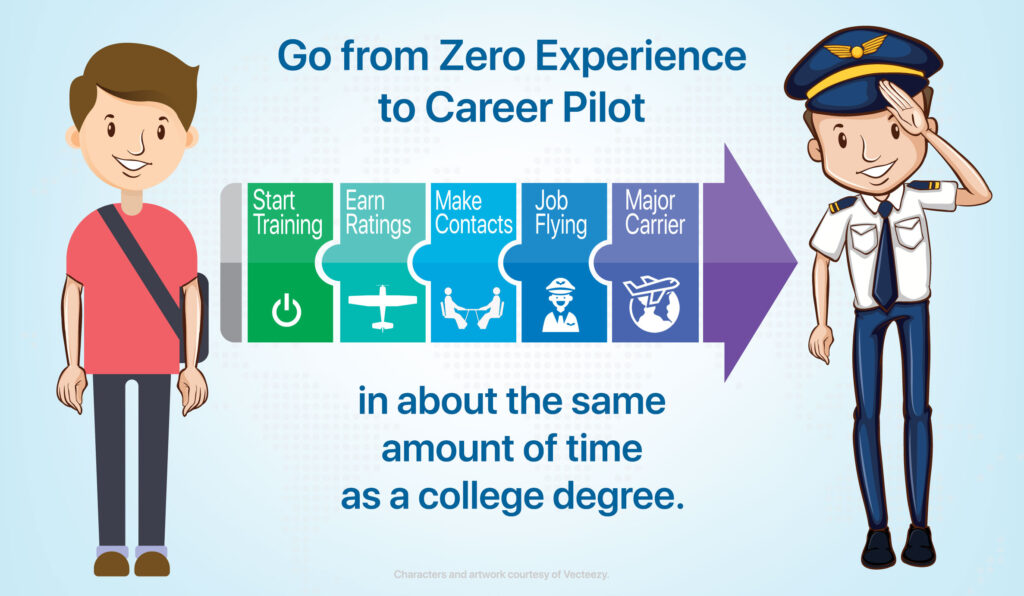
Have you ever wondered how pilots learn to fly airplanes? Or maybe you’re considering a career as a pilot and want to know what to expect from flight school. Well, in this article, we will explore the ins and outs of flight school and give you a better understanding of how it all works. So buckle up and get ready to soar through the skies of knowledge!
Flight school is where aspiring pilots go to learn the skills and knowledge necessary to safely operate an aircraft. It is a structured program that combines both classroom instruction and hands-on flight training. The duration of flight school can vary depending on the type of pilot’s license you are pursuing, but it generally takes several months to complete.
During the classroom portion of flight school, you will learn about basic aviation principles, navigation, aerodynamics, weather patterns, and aircraft systems. This theoretical knowledge is essential for understanding the technical aspects of flying. After completing the classroom instruction, you will move on to the practical training phase, where you will get behind the controls of an aircraft and start learning how to fly.
In the practical training phase, you will start with simulator sessions, which allow you to practice various flight scenarios in a controlled environment. This helps you build muscle memory and develop decision-making skills. As you progress, you will move on to actual flights with an instructor, where you will practice takeoffs, landings, maneuvers, and emergency procedures. The goal is to become proficient in flying different types of aircraft and to gain enough experience to pass the required flight tests and obtain your pilot’s license. In our upcoming article, we will delve deeper into the specifics of flight school and provide more insights into what goes on during the training process.

Understanding Flight School
Flight school is an essential step in pursuing a career as a pilot. Whether you aspire to become a commercial pilot, a private pilot, or join the military, proper training is crucial to ensure your safety and the safety of others when you take to the skies. In this article, we will explore the different aspects of flight school and how it operates. From the admission process to the curriculum and training, from the role of flight instructors to safety measures and regulations, we will provide a comprehensive understanding of how flight school works. So, let’s begin!
Introduction to Flight School
Flight school is an educational institution specifically designed to train aspiring pilots. It provides a structured program that includes both theoretical and practical training to equip students with the necessary skills and knowledge to fly an aircraft safely and efficiently.

Importance of Flight School
The importance of flight school cannot be overstated. Flying an aircraft requires specialized knowledge, skills, and experience. Flight school provides aspiring pilots with the opportunity to learn these skills under the guidance of experienced instructors. Without proper training, pilots would not be able to meet the standards set by aviation authorities, leaving them ill-prepared for the challenges they may face in the cockpit.
Different Types of Flight Schools
Flight schools come in different types, catering to a variety of students with different goals and aspirations. Some flight schools focus on training pilots for specific sectors, such as airline-based flight schools, military flight schools, or general aviation flight schools. Each type of flight school has its own unique curriculum and training approach, catering to the specific needs and requirements of its students.

Admission Process
The admission process to flight school typically involves several steps, starting with the requirements for admission, followed by the application process, entrance exams, and interviews.
Requirements for Admission
Flight schools have certain requirements that applicants must meet to be eligible for admission. These requirements can include a minimum age requirement, educational qualifications, physical fitness, and English language proficiency. The specific requirements may vary depending on the type of flight school and the country in which it is located.
Application Process
Once you have determined that you meet the admission requirements, you will need to complete the application process. This usually involves filling out an application form, providing supporting documents such as identification and educational certificates, and paying the application fee.
Entrance Exams and Interviews
After submitting your application, you may be required to take entrance exams to assess your aptitude and knowledge in areas such as mathematics, physics, and aviation theory. Additionally, you may be called for an interview to further evaluate your motivation, commitment, and suitability for the program.
Curriculum and Training
The curriculum and training at flight school are designed to provide a comprehensive learning experience that covers both theoretical and practical aspects of flying. Let’s take a closer look at the different components of flight school curriculum and training.
Ground School Training
Ground school is the theoretical component of flight training. It covers subjects such as aviation theory, flight regulations, meteorology, aircraft systems, navigation, and aerodynamics. Students learn about the principles of flight, how to read weather charts, interpret instruments, and calculate flight performance. Ground school training is essential to gain the necessary knowledge and understanding before taking to the skies.
Practical Flight Training
Practical flight training is the heart of flight school. It includes hands-on flying experience under the guidance of certified flight instructors. During this phase, students learn how to operate an aircraft, perform various maneuvers, take off and land, navigate, communicate with air traffic control, and handle emergency situations. Practical flight training is conducted in actual aircraft and provides students with the opportunity to apply the theoretical knowledge gained in ground school.
Simulator Training
Alongside practical flight training, flight schools often incorporate simulator training into their curriculum. Simulators are sophisticated devices that replicate the experience of flying an aircraft. They provide a safe and controlled environment for students to practice various flight scenarios and emergency procedures. Simulator training is an invaluable tool for developing and honing crucial flying skills without the risks associated with actual flight.

Flight Instructors
Flight instructors play a vital role in the training process. They are highly experienced pilots who have undergone rigorous training and certification to teach others how to fly. Let’s delve into the role of flight instructors, their qualifications, and the importance of the student-teacher relationship.
Role of Flight Instructors
Flight instructors are responsible for guiding and mentoring students throughout their training. They provide classroom instruction, oversee practical flight training, and evaluate student progress. Instructors are not only knowledgeable about aviation, but they also possess excellent communication and teaching skills to effectively impart their knowledge to students.
Qualifications and Certifications
To become a flight instructor, pilots must meet specific qualifications and certifications. In most countries, flight instructors must hold a commercial pilot license and have accumulated a certain number of flight hours. They must also complete additional training and pass examinations to obtain a flight instructor certificate. These certifications ensure that instructors have the necessary skills and knowledge to teach students effectively and safely.
Student-Teacher Relationship
Establishing a strong student-teacher relationship is crucial to the success of flight training. Flight instructors act as mentors, providing guidance, support, and motivation to their students. They create a learning environment that fosters open communication, trust, and respect. A positive student-teacher relationship enhances the learning experience and helps students feel confident and comfortable as they progress through their training.
Safety Measures and Regulations
Safety is of paramount importance in aviation, and flight schools are no exception. Flight schools implement various safety measures and adhere to strict regulations to ensure the safety of both students and instructors. Let’s explore the importance of safety measures, the role of the Federal Aviation Administration (FAA) in setting regulations, and emergency procedures.
Importance of Safety Measures
Safety measures are crucial to prevent accidents and ensure the safety of everyone involved in the flight training process. Flight schools implement protocols such as pre-flight inspections, safety briefings, and adherence to standard operating procedures. Safety measures also include maintaining aircraft in airworthy conditions, conducting regular maintenance checks, and following established emergency protocols.
FAA Regulations and Guidelines
The Federal Aviation Administration (FAA) in the United States is the regulatory agency responsible for overseeing aviation safety. It sets and enforces regulations and guidelines that flight schools must adhere to. These regulations cover areas such as pilot certification, aircraft maintenance, flight operations, and training standards. Flight schools must comply with FAA regulations to maintain accreditation and ensure a safe learning environment.
Emergency Procedures
Flight schools place significant emphasis on teaching students emergency procedures. Students learn how to handle various emergency situations, such as engine failures, instrument malfunctions, or unexpected weather conditions. Training in emergency procedures prepares students to remain calm, make critical decisions, and take the necessary actions to ensure the safety of the aircraft and its occupants.

Equipment and Facilities
Flight schools rely on a range of equipment and facilities to provide comprehensive training. Let’s explore the different types of aircraft used in training, simulation equipment, and training facilities.
Aircraft Used in Training
Flight schools use a variety of aircraft for training purposes. These aircraft range from small single-engine trainers to larger multi-engine aircraft. The choice of aircraft depends on the level of training and the type of license or certification students are seeking. Single-engine trainers are typically used for initial flight training, while more advanced aircraft are used for commercial and advanced pilot training.
Simulation Equipment
Simulators are a crucial component of flight training. Flight schools utilize simulators to replicate the experience of flying in a controlled environment. Simulators can simulate various types of aircraft and scenarios, allowing students to practice different flight maneuvers, emergency procedures, and instrument approaches. Simulation equipment provides students with a cost-effective and safe way to develop their skills and build confidence before transitioning to actual flight.
Training Facilities
Flight schools require adequate training facilities to support their operations. These facilities include classrooms for ground school instruction, briefing rooms for pre-flight discussions, and offices for flight instructors and administrative staff. Some flight schools may also have on-site accommodation, dining facilities, and recreational amenities to provide a comfortable learning environment for students.
Costs and Financing
The cost of flight school can vary significantly depending on factors such as the type of training, the duration of the program, and the flight school’s location. Let’s explore the different aspects of costs and financing options available for aspiring pilots.
Tuition Fees and Expenses
Flight school tuition fees typically include the cost of ground school instruction, practical flight training, simulator training, and examinations. Additionally, students may need to budget for expenses such as textbooks, study materials, flight equipment, and licensing fees. The exact cost can vary significantly between flight schools and may be influenced by factors such as the type of aircraft used and the region in which the school is located.
Financial Aid and Scholarships
Many flight schools offer financial aid programs and scholarships to help students with the cost of training. Financial aid can include loans, grants, or work-study opportunities. Scholarships are awarded based on merit, academic achievements, or other criteria established by the flight school or external organizations. Exploring these options can help alleviate the financial burden of flight training.
Private Financing Options
For students who do not qualify for financial aid or scholarships, private financing options are available. These may include personal loans, lines of credit, or assistance from family and friends. Private financing allows students to pay for their training in installments or upfront, depending on the terms of the financing arrangement.
Progress Evaluation
Throughout flight school, students undergo regular evaluations to assess their progress and readiness for the next phase of training. Let’s explore the various forms of exams and assessments, flight test procedures, and progression criteria.
Exams and Assessments
Flight schools utilize various forms of exams and assessments to evaluate student knowledge and understanding. These can include written examinations, quizzes, practical demonstrations, and oral assessments. Exams cover subjects taught in ground school, while practical assessments evaluate skills and performance during flight training. Regular exams and assessments provide feedback to students and instructors and help identify areas for improvement.
Flight Test Procedures
Flight tests are an essential part of flight school and are conducted to assess a student’s readiness for licensure or certification. These tests are typically conducted by designated examiners approved by aviation authorities. Flight tests evaluate the student’s ability to demonstrate proficiency in flight maneuvers, emergency procedures, navigation, communication, and decision-making. Passing the flight test is a significant milestone in a student’s journey towards becoming a pilot.
Progression Criteria
Flight schools have established progression criteria that students must meet to advance to the next phase of training. These criteria can include minimum flight hours, completion of specific flight maneuvers, successful completion of exams and assessments, and overall performance evaluations. Meeting these criteria ensures that students have acquired the necessary skills and knowledge before moving on to more advanced training.
Job Placement and Careers
Flight schools often provide job placement support and guidance to assist students in their transition to the workforce. Let’s explore the job placement process, career opportunities available to pilots, and the importance of further training and certifications.
Job Placement Support
Flight schools often have partnerships or connections with airlines, charter companies, and other aviation organizations. This allows them to provide job placement support to their graduates. Job placement support can include assistance with resume writing, interview preparation, networking opportunities, and access to job listings. Flight schools often leverage their industry connections to help students secure employment after completing their training.
Career Opportunities
The completion of flight school opens up a wide range of career opportunities for pilots. Jhdfjahdk
Challenges and Tips for Success
Flight school can be mentally and physically challenging, requiring dedication, perseverance, and discipline. Let’s explore some common challenges faced by students and provide effective study techniques and time management tips to help you succeed.
Common Challenges Faced
Flight school presents various challenges that students may encounter throughout their training. Some common challenges include the volume of knowledge to be absorbed, time management, maintaining focus and motivation, and dealing with performance anxiety. Recognizing and addressing these challenges is essential for success in flight school.
Effective Study Techniques
Developing effective study techniques is crucial for maximizing learning and retention. Some effective study techniques for flight school include active learning, breaking down complex information into smaller chunks, using visual aids, practicing self-quizzing, and seeking clarification from instructors whenever needed. Experimenting with different study techniques and finding what works best for you can significantly enhance your learning experience.
Time Management Tips
Time management is essential for successfully completing flight school and staying on top of coursework and flight training. Some time management tips for flight school students include creating a schedule, setting realistic goals, prioritizing tasks, minimizing distractions, and making efficient use of available resources. Effective time management helps students balance their academic and practical training requirements, ensuring a productive and rewarding flight school experience.
Benefits and Rewards
Completing flight school and becoming a pilot comes with numerous benefits and rewards. Let’s explore some of the personal and professional advantages of pursuing a career in aviation.
Personal Growth and Confidence
Flight school provides an environment that fosters personal growth and development. As you acquire new knowledge and skills, you build confidence in your abilities as a pilot. Overcoming challenges, facing new experiences, and achieving milestones throughout flight school contribute to personal growth, resilience, and self-assurance.
Professional Advancement
Becoming a pilot opens up a world of professional opportunities. Whether you choose to fly for an airline, work as a flight instructor, become a corporate pilot, or join the military, a career in aviation offers diverse avenues for advancement. As you gain experience and log flight hours, you can progress to higher-level positions with increased responsibilities and rewards.
Lifelong Passion for Flying
For many pilots, flying is more than just a career—it is a lifelong passion. Completing flight school and becoming a licensed pilot allows you to indulge in your love for aviation. Flying becomes not only a profession but also a hobby and a way of life. The sense of freedom, the thrill of taking to the skies, and the continuous learning and exploration make flying a deeply fulfilling pursuit.
Success Stories
Flight school has produced countless success stories of individuals who have pursued their dreams of becoming pilots. Let’s explore some inspirational stories from flight school graduates, notable alumni achievements, and impactful flying careers.
Inspirational Stories from Flight School Graduates
Flight school graduates often share their personal journeys and stories to inspire others. These stories may highlight the challenges they overcame, the sacrifices they made, and the ultimate success they achieved. Inspirational stories from flight school graduates serve as a reminder that with dedication, hard work, and determination, anyone can pursue their dreams of flying.
Notable Alumni Achievements
Flight schools often have notable alumni who have achieved significant accomplishments in their aviation careers. These individuals may have become successful airline pilots, military aviators, entrepreneurs in aviation-related industries, or pioneers in aviation research and technology. Notable alumni achievements serve as a testament to the quality of education and training provided by flight schools.
Impactful Flying Careers
Flying opens up opportunities to make a meaningful impact on society. Many pilots choose careers that allow them to contribute to humanitarian efforts, emergency medical services, search and rescue operations, and environmental conservation. These impactful flying careers highlight the positive influence that pilots can have on the world and exemplify the ways in which flight school can lead to fulfilling careers that make a difference.
Choosing the Right Flight School
Choosing the right flight school is a crucial decision that can greatly impact your training experience and future career. Let’s explore some factors to consider when selecting a flight school, the importance of researching and comparing schools, and the benefits of visiting and networking.
Factors to Consider
When choosing a flight school, several factors should be taken into account. These can include the reputation and accreditation of the school, the qualifications and experience of the flight instructors, the availability and condition of training aircraft, the curriculum and training approach, the support services provided, and the cost of training. Assessing these factors helps ensure that the flight school aligns with your goals and requirements.
Researching and Comparing Schools
Researching and comparing different flight schools is essential to make an informed decision. Online resources, forums, and reviews can provide valuable insights into the reputation and quality of different flight schools. Comparing factors such as tuition fees, the duration of the program, student-to-instructor ratios, and the success rate of graduates helps identify the schools that are most suitable for your needs.
Visiting and Networking
Visiting prospective flight schools and networking with current students and alumni provides firsthand information and a feel for the learning environment. On-campus visits allow you to observe classrooms, training facilities, and interact with instructors and staff. Networking with current students and alumni helps gain insights into their experiences, career trajectories, and recommendations. These visits and networking opportunities contribute to making an informed decision about the right flight school for you.
Conclusion
Flight school plays a crucial role in building the foundations for a successful aviation career. By providing a structured program that combines theoretical knowledge and practical training, flight school equips aspiring pilots with the necessary skills, knowledge, and experience to take to the skies safely. From the admission process to curriculum and training, from the role of flight instructors to safety measures and regulations, flight school encompasses a comprehensive journey of learning and growth. So, if you have dreams of becoming a pilot, embark on your flight school experience with dedication, perseverance, and a passion for flying. Your exciting future opportunities await!

